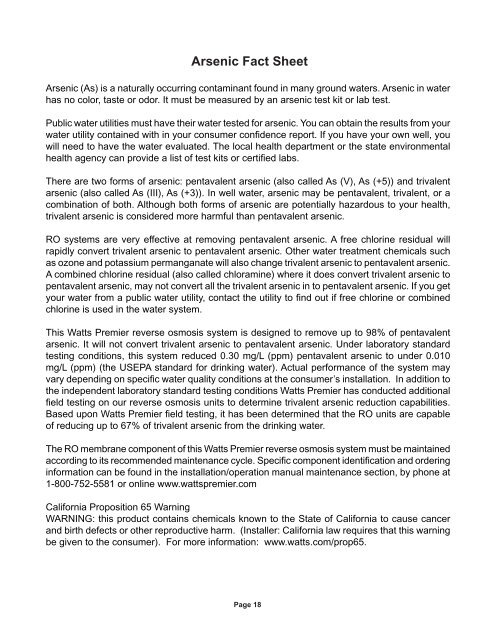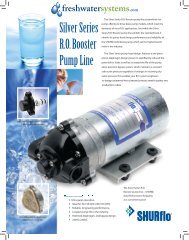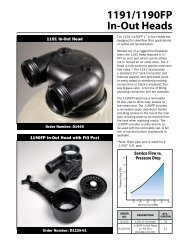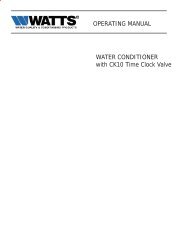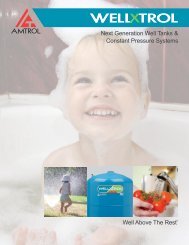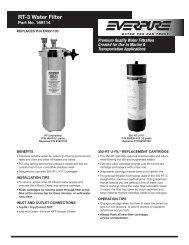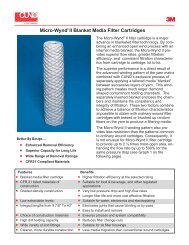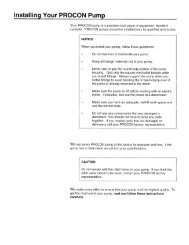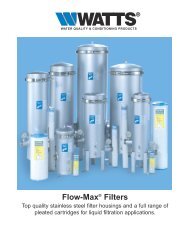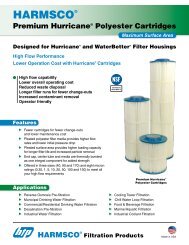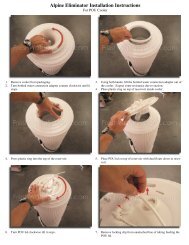Watts Premier RO Pure RO-4 Manual - Fresh Water Systems
Watts Premier RO Pure RO-4 Manual - Fresh Water Systems
Watts Premier RO Pure RO-4 Manual - Fresh Water Systems
Create successful ePaper yourself
Turn your PDF publications into a flip-book with our unique Google optimized e-Paper software.
Arsenic Fact Sheet<br />
Arsenic (As) is a naturally occurring contaminant found in many ground waters. Arsenic in water<br />
has no color, taste or odor. It must be measured by an arsenic test kit or lab test.<br />
Public water utilities must have their water tested for arsenic. You can obtain the results from your<br />
water utility contained with in your consumer confi dence report. If you have your own well, you<br />
will need to have the water evaluated. The local health department or the state environmental<br />
health agency can provide a list of test kits or certifi ed labs.<br />
There are two forms of arsenic: pentavalent arsenic (also called As (V), As (+5)) and trivalent<br />
arsenic (also called As (III), As (+3)). In well water, arsenic may be pentavalent, trivalent, or a<br />
combination of both. Although both forms of arsenic are potentially hazardous to your health,<br />
trivalent arsenic is considered more harmful than pentavalent arsenic.<br />
<strong>RO</strong> systems are very effective at removing pentavalent arsenic. A free chlorine residual will<br />
rapidly convert trivalent arsenic to pentavalent arsenic. Other water treatment chemicals such<br />
as ozone and potassium permanganate will also change trivalent arsenic to pentavalent arsenic.<br />
A combined chlorine residual (also called chloramine) where it does convert trivalent arsenic to<br />
pentavalent arsenic, may not convert all the trivalent arsenic in to pentavalent arsenic. If you get<br />
your water from a public water utility, contact the utility to fi nd out if free chlorine or combined<br />
chlorine is used in the water system.<br />
This <strong>Watts</strong> <strong>Premier</strong> reverse osmosis system is designed to remove up to 98% of pentavalent<br />
arsenic. It will not convert trivalent arsenic to pentavalent arsenic. Under laboratory standard<br />
testing conditions, this system reduced 0.30 mg/L (ppm) pentavalent arsenic to under 0.010<br />
mg/L (ppm) (the USEPA standard for drinking water). Actual performance of the system may<br />
vary depending on specifi c water quality conditions at the consumer’s installation. In addition to<br />
the independent laboratory standard testing conditions <strong>Watts</strong> <strong>Premier</strong> has conducted additional<br />
fi eld testing on our reverse osmosis units to determine trivalent arsenic reduction capabilities.<br />
Based upon <strong>Watts</strong> <strong>Premier</strong> fi eld testing, it has been determined that the <strong>RO</strong> units are capable<br />
of reducing up to 67% of trivalent arsenic from the drinking water.<br />
The <strong>RO</strong> membrane component of this <strong>Watts</strong> <strong>Premier</strong> reverse osmosis system must be maintained<br />
according to its recommended maintenance cycle. Specifi c component identifi cation and ordering<br />
information can be found in the installation/operation manual maintenance section, by phone at<br />
1-800-752-5581 or online www.wattspremier.com<br />
California Proposition 65 Warning<br />
WARNING: this product contains chemicals known to the State of California to cause cancer<br />
and birth defects or other reproductive harm. (Installer: California law requires that this warning<br />
be given to the consumer). For more information: www.watts.com/prop65.<br />
Page 18


